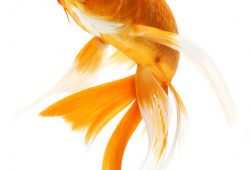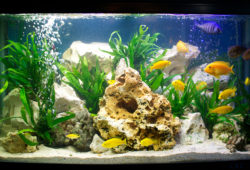The other Pelvicachromis
In the article I’ll tell you about The other Pelvicachromis. If you want to keep a dwarf cichlid in your community tank but aren’t quite sure about what you want to keep, how about the cousin of the popular Kribensis, Pelvicachromis taeniatus?

The conventional Kribs, P. pulcher, have become a bit mainstream and vary in quality and colour, but P. taeniatus remains a rarer find, is easier to keep and more hardy than other dwarfs like Apistogramma.
P. taeniatus has stunning colour and a lot going for it. It is a well-behaved community fish that will catch your eye, and will breed in a community tank.
Contents
What’s the difference?
Male P. taeniatus can look quite different from normal Kribs, whereas the females can look very similar. Geographical variants of both species may look even more alike, for instance there is a natural form of both P. taeniatus “Nigeria red” and P. pulcher “red” from Nigeria, with almost identical-looking females.
The main differences between most males of each species are that P. taeniatus has quite a prominent yellow upper lip and is more slender. It also has more colour in the anal fin than a male Krib, more black spots in the top of the tail (which is more rounded), whereas a male Krib’s tail is spade-shaped.
Mature male P. taeniatus also develop outlined scales on the flanks, a grey upper body and forehead that masks the brown, with horizontal barring across the flanks that is typical of most members of the genus. The amount of red on the belly depends on maturity, regional variation and water conditions.
You should be able to tell male and female fish apart quite easily. Again the male is more elongate, the female being stockier. She has more yellow on the face and is fully grown at 6cm/2.5″, with the male attaining 8cm/3″.
What’s available?
In the past ten years, not only has P. taeniatus become available in aquatic stores, but also in different geographical variants. Most stocks are commercially bred in the Czech Republic, and the results have been fish of good quality.
“Nigeria red” is the most popular form imported, but several others are available including “Calabar”, “Dehane”, “Kienke”, “Lobe” and “Moliwe”. Few shops will stock all variants, but prices are similar so expect to pay around £20 for a sexed pair. Specialist aquatic stores may be able to order you some.
Natural habitat
They originate in forest streams and rivers in Nigeria and Cameroon in West Africa, where the water is quite soft and acidic with a temperature range of 22-25°C/ 71.5-77ºF.
The water may be stained by tannins from wood and leaves, or even quite clear with sediment on the bottom. The fish use the cover from overhanging river banks and terrestrial vegetation, and are usually found close to the edge.
Aquarium requirements
P. taeniatus is straightforward to keep so long as its basic needs are met. Good quality water is required, so use power filtration and change the water regularly. A pH of 6.5-7.5 is OK, though they will breed in harder water.
The pH of water can alter the sex of Pelvicachromis fry, so if yours turn out to be 90% male, adjust the pH in time for the next spawning and see if that makes a difference.
Keep decor simple – a sand or gravel bottom with some rocks and bogwood are sufficient. Also provide caves in the form of flowerpots, coconut shells or hollow logs as they do like somewhere that is out of the way and may choose them as spawning sites.
Plants can certainly be added; this species is plant friendly. I have kept them in a full-blown Dutch-style planted aquarium with no disruption as they rarely dig or disturb plant roots.
For more basic planting, choose Vallisneria, Java fern and Java moss with some Amazon swords to create a forest scene. Lighting is not critical – anything from one to three light tubes on for 10 to 12 hours per day will be fine.
The tank should be as large as possible, though a 75cm/30″ length is the absolute minimum for a pair, and a 90cm/36″ or 120cm/48″ being better for a pair as part of a mixed community. Tank width is more important than height as they are mostly bottom dwelling.
They will accept a variety of foods including live, freeze-dried, frozen and dry foods such as flake and granules. Bloodworm is popular.
Tankmates
So long as tankmates don’t get too large or boisterous and have similar water requirements, you’ll be fine. If you want to breed them, leave out other cichlids and species that eat eggs and fry, like most catfish.
Loads of species are compatible like most barbs, rainbowfish and characins, or you could go down the themed route and add Congo tetras or African Red-eyed tetras for a West African tank. Smaller tetras like Cardinals are also OK.
Breeding
If the above conditions are provided, breeding may occur. Spawning is a secretive affair, and the first signs may be that the pair disappear for a few days. Or you may suddenly see a differently coloured flustered female trying to herd young around the tank. The eggs take up to five days to develop, and a further five days before fry are free swimming.
The male and female both participate in brood care, and 40-60 fry is a usual number. If you do see them with fry, don’t panic. The parents do an excellent job of rearing their fry, so you are better off leaving them to get on with it.
If the parents are attacking other fish to the point of nearly killing them, put in a divider as this is the easiest way to resolve the situation.
The ideal is to let a pair form of its own accord from a group of males and females, but at the prices they command, few people will have that luxury. If you get to choose a pair from a dealer’s tank, go for a nice, plump female and the best-looking male, or look for a pair that is swimming together.
If you do successfully rear the fry, you may be able to sell the young on to an aquatic store. Only expect to receive a fraction of what you paid for the adults, and don’t overproduce or inundate one store. Tell the dealers which variant they are so they can label them correctly and keep them separate to other variants and related species.
This article was first published in the January 2006 issue of Practical Fishkeeping magazine.



